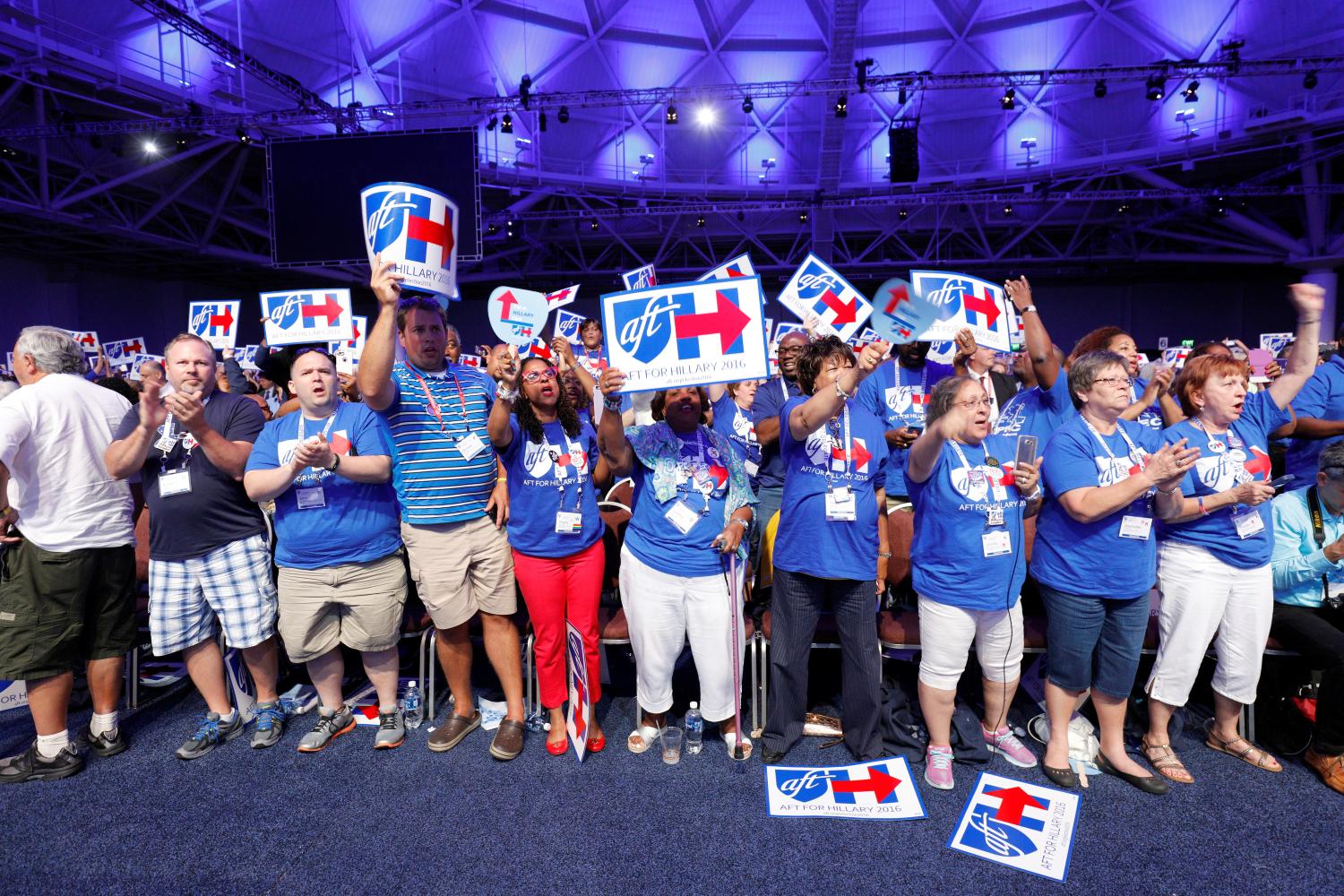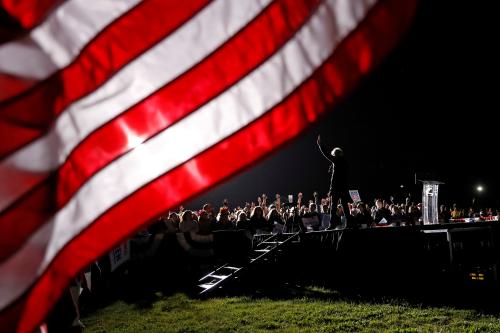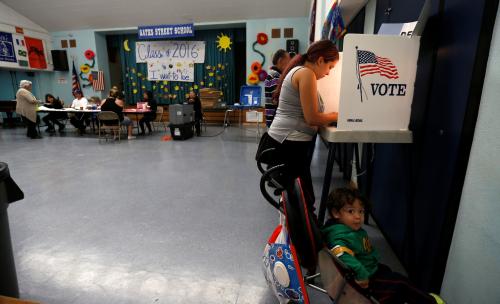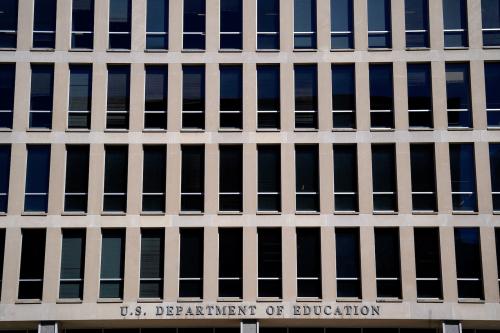While this year’s presidential campaign is atypical in many ways, it has thus far followed a familiar pattern in terms of education policy: education issues are not entirely absent from the debate, but they do not enjoy sufficient time in the spotlight. Donald Trump’s allergy to policy details makes it difficult to predict what he would actually do in office. What little he has said on education generally echoes Republican calls for local control, abandoning the Common Core State Standards, and supporting school choice.
Rather than compare the two candidates’ education policy platforms, I focus here on the politics at play within the Democratic party. An ongoing debate between teachers unions and civil rights organizations, two important constituencies within the Democratic party, has surfaced at multiple points over the course of this campaign—sometimes in the context of the election itself, and at other times in the context of ESSA implementation. This conflict, and what it means for Hillary Clinton (as well as future Democratic candidates and officeholders), is worth further discussion.
The nation’s two largest teachers unions, the National Education Association (NEA) and the American Federation of Teachers (AFT), boast 3 and 1.6 million members, respectively. These organizations routinely contribute huge amounts of money to the Democratic party. In 2012, they contributed roughly 19.2 million dollars—only $263,384, or about 1 percent, of these contributions went to Republicans, while the rest went to liberal groups and Democrats. The 2012 campaign was not an aberration; as the graph below shows, teachers unions regularly contribute overwhelmingly to Democrats. And compared to other organizations, the NEA is a big spender. Since 1989, the NEA “has been the fourth biggest donor out of all organizations tracked by [the Center for Responsive Politics].”
 Source: Center for Responsive Politics, OpenSecrets.org
Source: Center for Responsive Politics, OpenSecrets.org
Black voters and civil rights groups routinely and overwhelmingly support the Democratic party as well. Particularly since 1964, when the majority of black voters moved decisively into the Democratic party followed by the departure of Southern Democrats for the GOP, black voters and civil rights groups have been critical members of the Democratic coalition.[1] As the chart below shows, the vast majority of black voters have cast their ballots for the Democratic presidential candidate in recent history.
Teachers unions and the civil rights community are clearly both crucial Democratic constituencies. In today’s K-12 education politics, however, they increasingly find themselves on opposite sides of debates over important questions. Let me briefly detail the nature of these disagreements.
Given this country’s political and social history, it is no surprise that civil rights organizations support federal oversight of education. As I have written previously, during debates over ESSA implementation, the Leadership Conference on Civil and Human Rights (LCCHR) has made it clear that they believe the federal government should play a central role in implementing ESSA’s accountability provisions. President of LCCHR Wade Henderson also supports Secretary of Education John King’s controversial proposed regulations on how districts measure and allocate Title I spending under ESSA’s supplement-not-supplant (SNS) provision, referring to King’s proposal as “a step in the right direction.”
In contrast, teachers unions are vocal supporters of state and local control. Leaders of the NEA and AFT chafed under the Obama administration’s accountability requirements under both the Race to the Top and NCLB waiver programs, and this criticism has extended to many of King’s proposed ESSA regulations. While LCCHR supports King’s proposed accountability and SNS regulations, union leaders disagree. Regarding the SNS proposed rules released in August, Randi Weingarten, president of the AFT, characterized the rules as an “unfunded mandate from Washington.” In their comments on the Department of Education’s proposed regulations on accountability and state plans, the NEA argues that the Department “missed the mark.” Overall, during the ESSA implementation debates, union leaders have in fact often made the same case as Republicans in Congress, such as Sen. Lamar Alexander, in arguing for less federal regulation.
The 2016 election and Democratic party rifts
Coinciding with the presidential election, these high-profile debates over ESSA implementation bring into sharp focus the conflict between these two critical Democratic constituencies. The dust-up over the Democratic 2016 party platform exemplifies this tension. The platform was revised to more clearly include policies that the NEA and AFT endorse and to reject policies the unions oppose, such as linking teacher evaluation to student achievement as measured by standardized tests. The revisions were unwelcome news to civil rights groups such as the Democrats for Education Reform. The group’s national president, Shavar Jeffries, summarized the concern: “[the] platform stands in stark contrast to the positions of a broad coalition of civil rights groups.”
How is Hillary Clinton, the Democratic presidential candidate, navigating this conflict between two key constituencies? It is not clear where Clinton falls on all issues related to ESSA implementation over which teachers unions and civil rights organizations have sparred. But, the NEA and AFT have both endorsed her. And thus far, Clinton has aligned herself with a number of positions that reflect teachers unions’ preferences: she is opposed to tying teacher evaluation to student test scores and has indicated a preference for “fewer and better” tests.[2]
What political calculus informed these decisions? The motivation may be two-fold. First, civil rights organizations and the minority voters they represent are unlikely to abandon the Democratic party for the Republicans. Paul Frymer’s theory of “capture” is relevant here. In our two-party system, the Democratic party has laid claim to representing black voters’ interests, but if the Democratic party fails to address their needs, these voters lack a viable alternative. The same political institutions that produced our two-party system make the success of third parties very unlikely, so in this system, black voters and organizations that advocate on their behalf have little recourse if the Democratic party fails to address their needs.
It is thus very unlikely that Clinton would jeopardize support among civil rights groups and the black voters they represent even if she adopts positions on education policies that the civil rights community disagrees with. Particularly given Trump’s track record of racist comments, and considering that civil rights groups and the voters they represent are concerned not only about education issues but also about broader goals such as preserving and strengthening an inclusive society, the risk of large-scale defections or abstention is low.
On the other hand, Clinton and the Democratic party may in fact worry about jeopardizing support among teachers unions, along with their millions of members and campaign contributions. Teachers unions support state and local control of education. This position sounds startlingly close to the mainstream Republican argument for a less intrusive federal government and more state autonomy. And as teachers unions hesitantly begin to accept charter schools under certain circumstances, school choice may be less of a wedge between unions and Republicans than in the past. This is not to say that the NEA and AFT (and their members) are about to switch parties, but compared to civil rights organizations and the voters they represent, teachers unions may have more leverage in terms of a viable exit threat, in this and future elections.
In this context, Clinton’s strong signal to the teachers unions that she’s on board with central pillars of their agenda makes sense. Not only are these unions frustrated with President Obama’s policies, but their preference for state and local flexibility aligns closely with positions typically held by the Republican party. Clinton’s alignment with these positions neutralizes any threats for defection. On the other hand, while civil rights groups may be unhappy with some of Clinton’s policy positions, Clinton and the Democratic party are fully aware that these groups and many of the voters they represent are very unlikely to align with the Republican party on these and other policy issues or, in turn, to credibly threaten to support Republican candidates over Democrats.
It seems that, at least for this election cycle, Clinton has found a politically feasible strategy to address the rift over key education policies between teachers unions and civil rights groups. But this solution leaves the fundamental difference of opinion between these two important Democratic constituencies unresolved. While ESSA implementation may provide opportunities for these groups to reach jointly satisfying compromises, a less optimistic outlook suggests that 2016 is not likely the last election year in which Democratic candidates will face this difficult political calculus.
[1] See Chapter 8 in Divided by Color (Kinder and Sanders 1996) for a discussion of these partisan shifts that occurred during and after the 1964 presidential election.[2]Clinton has sent mixed messages on charter schools, rumpling feathers among charter advocates earlier on the campaign trail and, more recently, drawing boos from a crowd of union members when she spoke in favor of charters. The NEA and AFT do not officially oppose charters, while some civil rights groups support charters and others oppose them.
The Brookings Institution is committed to quality, independence, and impact.
We are supported by a diverse array of funders. In line with our values and policies, each Brookings publication represents the sole views of its author(s).








